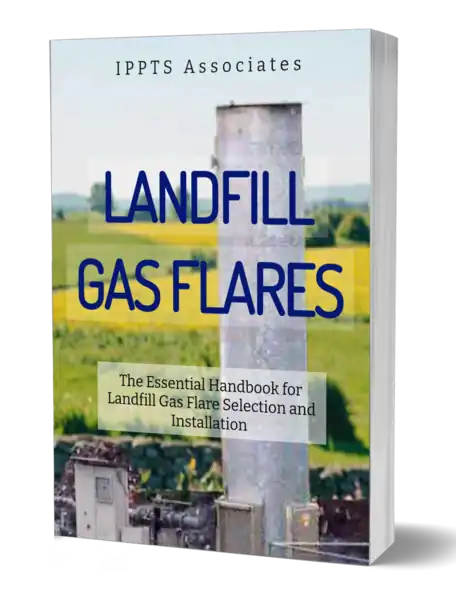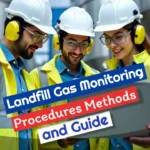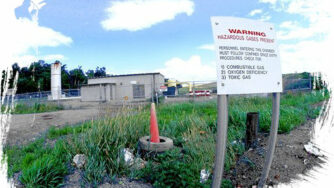Landfill Gas Flare Stack Monitoring Limitations
Stack monitoring, or more correctly “landfill gas flare monitoring“, can only be carried out on enclosed flares. Enclosed flares are the only landfill gas flare type which can demonstrably provide a known minimum residence time and therefore are the only landfill gas flare type which is now accepted for use in the UK.
Figure 1 – Enclosed Flare
Photo :Summerleaze Re-Generation Ltd
Even when enclosed landfill gas flares are used, regular emission monitoring of flares by taking discrete samples monthly or quarterly would not necessarily provide very worthwhile representative results for the flare's efficiency in reducing emissions during critical transient weather condition. So the approach for these simple devices, for ensuring that a reasonable s level of compliance is achieved, is for the type of flare and its specification for residence time at a minimum temperature, to be used for emissions compliance assessment.
Control through Design Specification
If the temperature in the combustion chamber is between 1000oC and 1200oC , a minimum retention time of 0.3 seconds is observed (as per TA Luft 2001) and the flare is properly maintained and operated, enclosed landfill gas flares are capable of providing a destruction efficiency of nearly 98-99% for methane and VOCs. Where compounds of chlorine, fluorine and sulphur are present in the inlet gas it is inevitable that they, or compounds derived from them, will be present in the flare emissions. Their presence in the emissions is predictable and the only way in which they may be controlled is by attention to the quality of the inlet gas.
Figure 2 Shows Flare Stack data for Flare Stacks in Ireland in the early 2000s.

The following Emission Control Strategy is therefore proposed:
- Impose flare design and operations standards that can easily be assessed (temperature, retention time, inlet gas rate of input).
- Impose emission standards only on those compounds that can be safely monitored and that are controlled by design of the flare (CO, NOx and unburned hydrocarbons).
- Specify limits for key compounds to be monitored in the inlet gas (HCl, HF, SOx) which, if exceeded, require removal. Calculations based on mass balance can then be carried out to the assess exit emissions impacts.
References & Interviewees

Refs: Guidance on Landfill Gas Flaring, UK EA 2002; Guidance on the Management of Landfill Gas (Draft), UK EA 2002; Landfill Gas Engine Exhaust and Flare Emissions LQM Ltd Sept.2002; Landfill Gas Flares and Engines Emissions Standards Shanks Int.Rpt 1999; Guidance on the Emissions from Types of Landfill Gas Flares, AEA Tech '97; TA.(Luft) 2001, Air Quality Guidelines, German Ministry of the Environment
Interviewees: Paul Glenister-Summerleaze Re-Generation Ltd; Andrew Leach- Renewable Power Systems; Norbert Salomon-German Ministry for the Environment; Edward Schokkar-Vereinigungs van Afvalverwerkehrs, Netherlands; Jörg Simon- Umweltanalytic RUK; Wolfgang Stachowitz- DAS-IB Gmbh; Graham White- Clarke Energy Ltd.
Funded work undertaken by: Elisabeth Nagel, & Brian Latham.
Conclusions:
In view of the fundamental difficulties inherent in extractive emissions sampling, a design and operational certification approach is proposed for the control of emissions from flares.
Proposed Design and Operational Certification Approach
Operational flare verification could consist of a 2-stage approach. 1) Initial identification of the type of flare required for a particular site, based on a site specific survey or modelling of the key elements of the landfill gas in question; 2) followed by flare performance verification based on once-off sampling of the flare when it is commissioned at the site. If all requirements are met, a Verification of Operational Performance Certificate could then be issued to the Flare Operators.
We recommend our ebook for all professional readers involved in any aspect of flare design, installation, operation, or maintenance:
What You’ll Get in This 26-Page PDF
When you download Landfill Gas Management & Flare System Design, you’ll get a powerful, expert-written guide packed with:
✅ Clear explanations of landfill gas behavior – Understand methane generation, gas composition, and why effective management matters more than ever under global climate pledges.
✅ Flare system selection criteria – Learn the differences between open and enclosed flares, low-calorie flare technology, and how to match systems to site-specific conditions.
✅ Design, sizing, and installation best practices – Includes guidance on capacity planning, site prep, equipment requirements, and modular approaches for evolving landfill needs.
✅ Compliance made simple – Navigate EPA, ATEX, DSEAR, and Clean Air Act requirements with confidence.
✅ Maintenance & troubleshooting tips – Stay ahead of breakdowns with proven maintenance schedules and common issue fixes.
✅ Real-world insights – Case studies, lessons learned from failures, and innovative technologies shaping the future of landfill gas control.
Perfect for landfill operators, engineers, consultants, and regulators — this compact guide delivers expert insight you can use right away to improve performance, cut emissions, and stay compliant.
Footnote:
 The first flares which were used on landfill sites were known as candle flares, and this type of flare is still common among other industries where flaring is normally used as a short term expedient during the start up of chemical processes when the gas may be of marginal quality, or not meet calorific minimum values, needed to run a generator or provide a feed import another process stage.
The first flares which were used on landfill sites were known as candle flares, and this type of flare is still common among other industries where flaring is normally used as a short term expedient during the start up of chemical processes when the gas may be of marginal quality, or not meet calorific minimum values, needed to run a generator or provide a feed import another process stage.
Landfill gas flares which are installed for the long term burning-off of landfill gas to reduce the global warming impact of the emission or for other reasons, are required by the UK regulators (and also in many other EU Countries) to be enclosed type flares. Candle flares have mostly been phased out and replaced by enclosed flare stacks in EU countries.
Candle flares are simpler and cheaper flare designs than their modern “enclosed combustion” counterpart.
Guidance on the emissions from different types of landfill gas flares (Technical aspects of controlled waste management)
UK Landfill Gas Emissions Control
The Stringent EA Controls, Which Limit UK Landfill Gas Emissions to Minimise the Emission of Carbon Dioxide thought to be a Significant Cause of Climate Change The UK waste management industry is required to control landfill gas emissions to a high standard. The Environment Agency (EA) is responsible for regulating landfills and ensuring that all […]
Landfill Gas Monitoring Procedures Methods and Guide
Landfill gas (LFG) monitoring procedures involve routine, site-specific procedures to detect gas leaks and ensure operational compliance, including monitoring methane, carbon dioxide, and other trace gases using portable instruments and fixed systems. Read on for our explanation of good practice procedures that include wellhead monitoring for oxygen, nitrogen, and carbon monoxide, perimeter monitoring for ambient […]
Best Portable Landfill Gas Analyzer Reviews & Comparison
Landfill gas monitoring is critical for health, safety, and compliance. A top-notch portable analyzer detects harmful gases in real-time, safeguarding workers and the environment. As regulations tighten, reliable equipment becomes essential for avoiding fines and mitigating risks associated with gas emissions from decomposing waste…
Landfill Gas Flares – Selection Installation And Maintenance
Landfill gas flares are now destined to be installed in a lot more landfills globally after COP26. This article is intended to help the anticipated influx of industry newcomers with their Landfill Gas Flare selection, installation, and maintenance. One of the international pledges made during the UN International Climate Change Conference 2021 otherwise known as […]










Offers on turn-key landfill gas flare rental. The unit provided is a skid mounted unit, and includes two centrifugal blowers, gas scrubber, analyzer, and flare ignition and control system capable of 100-500 scfm.
Can a gas flare produce an odor, even through the flame while it is burning? We think we have this problem.
What to do about vegetation? Mow area first. What to do?